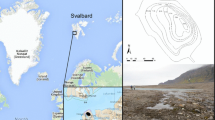Abstract
We studied abundance, annual survival, and recruitment of nine lake charr, Salvelinus namaycush, populations at the Experimental Lakes Area, Ontario, for periods of 9–24 years. We used the Jolly–Seber mark-recapture method to evaluate abundance and annual survival in all populations, and total catches of individual year classes to evaluate recruitment. Seven populations were unexploited and unaffected by whole-lake experiments. One population was exploited prior to mark-recapture study and another was affected by experimental acidification. Abundance ranged from 8 to 24 fish ha−1 in the unaffected populations. Annual survival ranged from 78% to 93% yr−1 in all populations except the exploited population. This population may have been additionally affected by northern pike, Esox lucius, predation. Yearly recruitment was relatively constant in all populations and related to lake charr abundance. Lake charr abundance did not recover in populations affected by exploitation or acidification. Unexploited lake charr populations were characterized by relatively constant abundance, high annual survival, and relatively constant annual recruitment.
Similar content being viewed by others
References cited
Arnason, A.N. & K.H. Mills. 1987. Detection of handling mortality and its effects on Jolly- Seber estimates for mark-recapture experiments. Can. J. Fish. Aquat. Sci. 44(Suppl. 1): 64–73.
Burr, J.M. 1997. Growth, density, and biomass of lake trout in Arctic and subarctic Alaska. pp. 109–118. In: J. Reynolds (ed.) Fish Ecology in Arctic North America, Amer. Fish. Soc. Symp. 19, Bethesda.
Christie, W.J. 1974. Changes in the fish species composition of the Great Lakes. J. Fish. Res. Board Can. 31: 827–853.
Cleugh, T.R. & B.W. Hauser. 1971. Results of the initial survey of the Experimental Lakes Area, northwestern Ontario. J. Fish Res. Board Can 28: 129–137.
Ferreri, C.P. & W.W. Taylor. 1996. Compensation in individual growth rates and its influence on lake trout population dynamics in Michigan waters of Lake Superior. J. Fish Biol. 49: 763–777.
Haw, F., P.K. Bergman, R.D. Fralick, R.M. Buckley & H.L. Blankenship. 1990. Visible implanted fish tag. Amer. Fish. Soc. Symp. 7: 311–315.
Healey, M.C. 1978a. The dynamics of exploited lake trout populations and implications for management. J. Wildl. Manage. 42: 307–328.
Healey, M.C. 1978b. Fecundity changes in exploited populations of lake whitefish (Coregonus clupeaformis) and lake trout (Salvelinus namaycush). J. Fish. Res. Board Can. 35: 945–950.
Healey, M.C. 1980. Growth and recruitment in experimentally exploited lake whitefish (Coregonus clupeaformis) populations. Can. J. Fish. Aquat. Sci. 37: 255–267.
Jolly, G.M. 1965. Explicit estimates from capture-recapture data with both death and immigration - stochastic model. Biometrika 52: 225–247.
Johnson, W.E. & J.R. Vallentyne. 1971. Rationale, background, and development of the Experimental Lakes Studies in northwestern Ontario. J. Fish. Res. Board Can. 28: 123–128.
Keleher, J.J. 1972. Great Slave Lake: effects of exploitation on the salmonid community. J. Fish. Res. Board Can. 29: 741–753.
Mills, K.H. & R.J. Beamish. 1980. Comparison of fin-ray and scale age determinations for lake whitefish (Coregonus clupeaformis) and their implications for estimates of growth and annual survival. Can. J. Fish. Aquat. Sci. 37: 534–544.
Mills, K.H., S.M. Chalanchuk, L.C. Mohr & I.J. Davies. 1987. Responses of fish populations in Lake 223 to 8 years of experimental acidification. Can. J. Fish. Aquat. Sci. 44(Suppl. 1): 114–125.
Mills, K.H., S.M. Chalanchuk, D.J. Allan & L.C. Mohr. 1993. Responses of lake whitefish (Coregonus clupeaformis) to exploitation at the Experimental Lakes Area, northwestern Ontario. Arch. Hydrobiol. Spec. Issues Advanc. Limnol. 46: 361–368.
Mills, K.H., S.M. Chalanchuk & D.J. Allan. 2000. Recovery of fish populations in Lake 223 from experimental acidification. Can. J. Fish. Aquat. Sci. 57: 192–204.
Ricker, W.E. 1975. Computation and interpretation of biological statistics of fish populations. Bull. Fish. Res. Board Can. 191. 382 pp.
Sakagawa, G.T. & R.L. Pycha. 1971. Population biology of lake trout (Salvelinus namaycush) of Lake Superior before 1950. J. Fish Res. Board Can. 28: 65–71.
Seber, G.A.F. 1982. The estimation of animal abundance and related parameters, 2nd ed. Macmillan Publishing Inc., New York. 654 pp.
Scott, W.B. & E.J. Crossman. 1973. Freshwater fishes of Canada. Bull. Fish. Res. Board Can. No. 184. 965 pp.
Shuter, B.J., M.L. Jones, R.M. Korver & N.P. Lester. 1998. Ageneral, life history based model for regional management of fish stocks: the inland lake trout (Salvelinus namaycush) fisheries of Ontario. Can. J. Fish. Aquat. Sci. 55: 2161–2177.
Walters, C.J., G. Steer & G. Spangler. 1980. Responses of lake trout (Salvelinus namaycush) to harvesting, stocking, and lamprey reduction. Can. J. Fish Aquat. Sci. 37: 2133–2145.
Welch, H.E. & K.H. Mills. 1981. Marking fish by scarring soft fin rays. Can. J. Fish. Aquat. Sci. 38: 1168–1170.
White, W.J. & R.J. Beamish. 1972. A simple fish tag suitable for long-term marking experiments. J. Fish. Res. Board Can. 29: 339–341.
Author information
Authors and Affiliations
Rights and permissions
About this article
Cite this article
Mills, K.H., Chalanchuk, S.M. & Allan, D.J. Abundance, Annual Survival, and Recruitment of Unexploited and Exploited Lake Charr, Salvelinus Namaycush, Populations at the Experimental Lakes Area, Northwestern Ontario. Environmental Biology of Fishes 64, 281–292 (2002). https://doi.org/10.1023/A:1016058705612
Issue Date:
DOI: https://doi.org/10.1023/A:1016058705612



